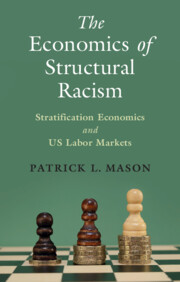Book contents
- The Economics of Structural Racism
- Cambridge Studies in Stratification Economics: Economics and Social Identity
- The Economics of Structural Racism
- Copyright page
- Dedication
- Contents
- Figures
- Tables
- Part I Foundations
- 1 Introduction
- 2 Racial Identity As an Economic Norm
- 3 Mechanisms of Stratification
- 4 Regimes of Racial Stratification
- Part II African American Educational Progress and Transformations in Family Structure, 1965–Present
- Part III African American Income and Wealth, 1965–Present
- Part IV Structural Racism, 1965–Present
- Part V Restatement and Discussion
- References
- Index
2 - Racial Identity As an Economic Norm
from Part I - Foundations
Published online by Cambridge University Press: 06 April 2023
- The Economics of Structural Racism
- Cambridge Studies in Stratification Economics: Economics and Social Identity
- The Economics of Structural Racism
- Copyright page
- Dedication
- Contents
- Figures
- Tables
- Part I Foundations
- 1 Introduction
- 2 Racial Identity As an Economic Norm
- 3 Mechanisms of Stratification
- 4 Regimes of Racial Stratification
- Part II African American Educational Progress and Transformations in Family Structure, 1965–Present
- Part III African American Income and Wealth, 1965–Present
- Part IV Structural Racism, 1965–Present
- Part V Restatement and Discussion
- References
- Index
Summary
Structural racism requires racialized economic agents. Racial identities are a strategically determined social norm, designed for governing differential access to resources, especially wealth, power, and information, as well as protection from other-group antagonism. When applied to the labor market, the differential power of racial groups means that racial identity is a sorting mechanism, such that persons of otherwise equal productive capacity will have racially differential access to employment, compensation, promotion, training, and the probability of layoff according to the manager–worker identity match. Racial identity norms evolve from social interactions between and among persons of alternative ancestral groups. Within these interactions persons select strategies that strengthen or weaken racial identity norms. These social interactions increase the productivity of persons if they are mutually altruistic. Mutually antagonistic social interactions reduce each person’s productivity. Racialization is an ongoing process of social and economic evolution. Self-identification and labeling conventions are social norms that emerge to distinguish social groups. Both actual and perceived skin shade and other physical differences are imprecise and subjective.
Keywords
- Type
- Chapter
- Information
- The Economics of Structural RacismStratification Economics and US Labor Markets, pp. 16 - 38Publisher: Cambridge University PressPrint publication year: 2023

